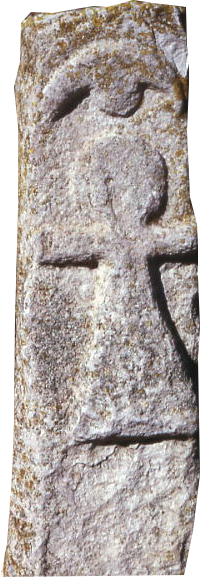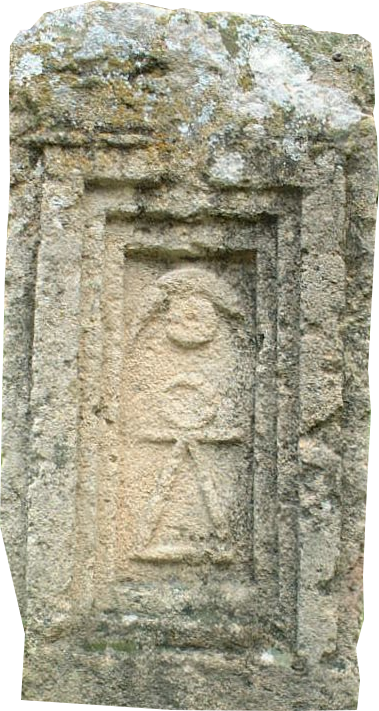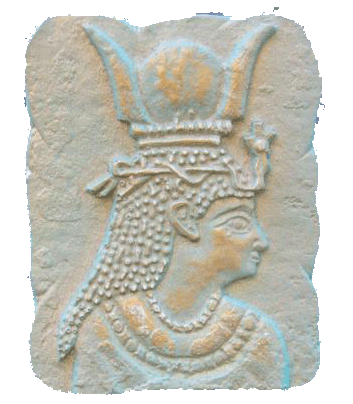Ancient Psychedelia: Alien Gods & Mushroom Goddesses
Online Book - Chapter 9, Page 146
Back to Online Book Mainpage / Next Page (Chapter 9, Page 147)
  R: (15j) Tanit, Carthage, Tunisia Baalat, or Ba'alat, is a title, referring to “Mistress,” “Lady,” or “Queen.” During the Phoenician Era, she was considered the main deity of the city of Byblos, a city on the coast of Lebanon, a few kilometers north of Beirut, known today in Arabic language as Jbeil. The temple of Ba‘alat Jbeil in Byblos was built around 2700 BC. Images of Ba’alat have her wearing a pair of bull horns above her head and an orb or inside it (13d). (52) In ancient Arabic, the word for nature spirits was ba’alim, which represented holy stones, trees, water and mountains. (53) Carthage was called the “City of the King of Health,” and its patron god was Eshmun-Astarte. (54)  (13d) Ba‘alat Gebal Eshmun was a healing divinity of Phoenicia and the chief divinity of Sidon. A female deity of Sidon, Ashima (55) was his spouse, claimed by Eiselen, to be the goddess Astarte. (56) Eshmun was the early predecessor to Asclepius. A trilingual inscription of the 2nd century BC from Sardinia identifies Eshmun with the Greek Asclepius and the Latin Aesculapius. (57) It’s likely he was originally a nature divinity of sorts as he was associated with the god Adonis and Tammuz in early Babylonian times. In Babylonian, Dumuzu is a variant form of Duzu and Eshmun is the Phoenician name of Tammuz or Dumuzu. (58) |
Philistines The people called the Philistines were of Aegean origin and settled on the southern coast of what is now called Palestine around the 12th century BC. (59) The Philistines were said to come from Caphtor. According to the words of Deuteronomy: (23) And as for the Avvites who lived in villages as far as Gaza, the Caphtorites coming out from Caphtor destroyed them and settled in their place. (Deuteronomy 2:23) (4) The LORD is about to destroy the Philistines, the remnant from the coasts of Caphtor. (Jeremiah 47:4) The Philistines held Dagon, their version of El, to be the local deity. Oannes, Ea, Enki, Dagon and El are all the same god. In Sumer he is assigned the serpent identity. Only in the Babylonian and Philistine versions of his mythos is he a fish-god. The word Dag means fish in Hebrew. But the word Dagan means wheat, cereal, grain or corn. So, there is much debate whether he was a grain or a fish god to the Philistines. (60) He may have been depicted as a fish, but there were no fish gods. Like it really matters, though. He was a mushroom god as far as I am concerned. In Mesopotamia, the earliest textual references to Dagan come from the Royal Inscriptions of Sargon (2334 - 2279 BC) and Naram-Sin (2254 - 2218 BC). (61) (52) When God was a Woman, p. 208; http://alyafi-ip.com/2009-baalat-la-dame-de-jbeil-lady-byblos (53) Healing Gods, p. 132-33 (54) ibid, p. 141; Corpus Inscriptionum Latinarum I, 245, 3-4 (55) II Kings, XVII, 30 (56) Frederick Carl Eiselen (1907). Sidon: A Study in Oriental History, Volume 4. Columbia University Press, p. 127 (57) KAI H. Donner and W. Rollig, Kanaanäische und aramäische Inschriften (66) (58) Healing Gods, p. 135-6; The Genesis of the God Eshmun by George A. Barton, Professor in Bryn Mawr College, Bryn Mawr, Penna. – Journal of Oriental Society Vol. 21, Index to the Journal of the American Oriental Society, Vols. 1-20 (1900), pp. 188-190) (Die Phoenizier, Bd. I, 1841, p. 226 ff, and Baethgen’s Beitrage zur semitische Religionsgeschichte, p. 44 (59) https://www.britannica.com/topic/Philistine-people (60) Jealous Gods, p. 90 (61)http://oracc.museum.upenn.edu/amgg/ listofdeities/dagan/index.html |
Go Back to Page 145